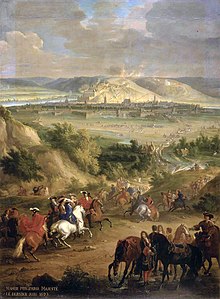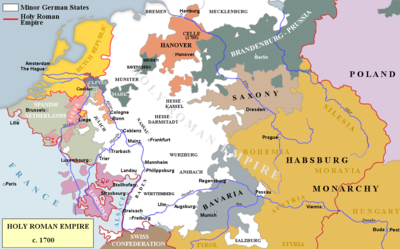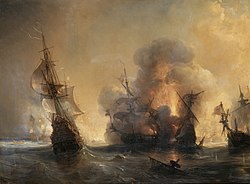Grand Alliance (League of Augsburg)

 Clash Royale CLAN TAG#URR8PPP
Clash Royale CLAN TAG#URR8PPP | Grand Alliance between England, the United Provinces and Austria | |
|---|---|
 The Nine Years War; Siege of Namur, 1692; | |
| Context | Anti-French Coalition |
| Signed | 20 December 1689 (1689-12-20) |
| Location | The Hague |
| Parties |
|
The Grand Alliance is the name commonly used for the coalition formed on 20 December 1689 by England,[b] the Dutch Republic and Holy Roman Emperor Leopold, including the Archduchy of Austria.[c] With the later additions of Spain and Savoy, this fought the 1688–97 Nine Years' War against France that ended with the 1697 Treaty of Ryswick.
The Alliance was reformed in September 1701 by the Treaty of The Hague shortly before the War of the Spanish Succession and dissolved after the 1714 Peace of Utrecht. This is often referred to as the Second Grand Alliance.
Contents
1 Background
2 Formation
3 Membership; League of Augsburg v Grand Alliance
4 Provisions
5 Aftermath
6 Footnotes
7 References
8 Sources
Background

Many Protestant states felt threatened by the persecution of French Huguenots
The Grand Alliance was the most significant of the coalitions formed in response to the wars of Louis XIV that began in 1667 and ended in 1714. Post-1648, French expansion was helped by the decline of Spanish power while the Peace of Westphalia formalised religious divisions within the Holy Roman Empire. This weakened the collective security previously provided by the Imperial Circles and led to a series of individual agreements, such as the 1679 Wetterau Union.[d][1]
Louis XIV attempted to weaken Austrian influence by supporting their Ottoman opponents in the 1683–99 Great Turkish War, while paying subsidies to states that were part of the Holy Roman Empire, including Bavaria, the Palatinate, Cologne and Brandenburg-Prussia. The Protestant Kingdom of Denmark also received subsidies and when James II became King of England in February 1685, it was assumed he too would become a French ally.
In 1670, France occupied the Duchy of Lorraine, then much of Alsace in the 1683–84 War of the Reunions, threatening Imperial states in the Rhineland. The October 1685 Edict of Fontainebleau revoked tolerance for French Huguenots, an estimated 200,000 - 400,000 of whom left France over the next five years.[2] Former allies like Frederick William now invited French exiles to settle in Brandenburg-Prussia and agreed a treaty with the Dutch Republic in October 1685.[3] These events were followed in 1686 by the massacre of around 2,000 Vaudois Protestants, reinforcing widespread fears that Protestant Europe was threatened by a Catholic counter-reformation led by Louis XIV.[4]
Formation

The Imperial Circles ca 1560; these grouped states within the Empire for mutual defence and support. The Burgundian Circle shown here includes the Dutch Republic, which became independent in 1648.
With Leopold occupied by the Ottomans, William of Orange led efforts to create a coalition of Imperial German states to resist French expansion and 'preserve the peace and liberties of Europe.'[5] As it was outside the Empire, the Dutch Republic was excluded from the Union of Wetterau but many of its leaders were senior officers in the Dutch army or closely connected to William. This included its head, Georg Friedrich, Prince of Waldeck and architect of its most lasting achievement. For the first time, members funded a central 'Union' army, rather than men, which greatly improved its effectiveness.[6]
His model was used for the 1682 Laxenburg Alliance. This combined Austria, the Upper Rhenish and Franconian Circles to defend the Rhineland but the War of Reunions proved it was insufficient to oppose France on its own.[7] When Philip William, Duke of Berg and Jülich inherited the Palatinate in May 1685, Louis claimed half of it, creating another crisis.[e][8] The failure of previous coalitions made it clear a stronger, more widely based alliance was needed to defend the Palatinate.

William III ca 1690s
Victory over the Ottomans at the Battle of Vienna in 1683 allowed Leopold to refocus on the western portions of the Empire.[9] The League of Augsburg was formed in July 1686 by combining the Laxenburg Alliance with the Burgundian Circle, Swedish Pomerania and Bavaria.[10]
On 27 September 1688, French forces invaded the Rhineland and attacked Philippsburg, launching the Nine Years' War. The coalition was strengthened when the Glorious Revolution deposed James II in November 1688 and William of Orange became William III/II of England and Scotland. The Dutch Republic declared war on France in March 1689, followed by England in May.
Membership; League of Augsburg v Grand Alliance
The overlap between the various coalitions is often confusing. The Empire contained hundreds of members, each belonging to an Imperial Circle (see map), an administrative unit for collecting taxes and mutual support; the Swabian Circle alone had over 88 members. Individual states could form or join alliances, such as the 1685 agreement between Brandenburg-Prussia and the Dutch Republic, while Leopold signed the Grand Alliance as Archduke of Austria.[11] However, only the Imperial Diet could commit the entire Empire; the Nine Years War was not declared an 'Imperial' one, unlike the 1701–14 War of the Spanish Succession.[f][12]
A number of foreign monarchs held titles and lands within the Empire; Charles XI of Sweden was King of Sweden, which was technically neutral. He was also Duke of Swedish Pomerania, a member of the Lower Saxon Circle and part of the League. The same applied to the Spanish Netherlands, a member of the Burgundian Circle, but not the Kingdom of Spain, which separately joined the Grand Alliance in 1690.
Lastly, some writers fail to differentiate between the 'Grand Alliance,' as in England, the Dutch Republic and Leopold, versus members of the anti-French 'alliance,' like Bavaria, the Palatinate, etc. Seventeenth-century European society was extremely hierarchical; the Grand Alliance acknowledged the Dutch Republic and England as Leopold's equals, a status he guarded with great care. This made Savoy's entry into the Alliance in 1690 a major triumph for Victor Amadeus but Leopold refused to allow Bavaria and Brandenburg-Prussia separate representation at the Ryswick peace talks in 1697.
Provisions

The Rhineland 1688–89.
The terms of the Grand Alliance were largely based on the agreements of May 1689 between the Dutch Republic and Austria and the August 1689 Anglo-Dutch 'Treaty of Friendship and Alliance.'[13] It was finally signed on 20 December 1689, delayed by Leopold's concerns on accepting William as King of England and the impact on English Roman Catholics.[14]
The main provisions were restoration of the borders agreed at Westphalia in 1648, the independence of the Duchy of Lorraine and French recognition of the Protestant Succession in England. Signatories also bound themselves not to agree a separate peace; despite previous commitments, this happened at the 1678–79 Treaties of Nijmegen and greatly improved France's negotiating position.[15]
A secret clause committed England and the Dutch Republic to support Leopold's claims to the Spanish throne.[16] What would happen when the childless Charles II of Spain died had been discussed since his birth in 1661 and featured in many agreements of the period.[g]
Aftermath

The Grand Alliance halted the expansion of France under Louis XIV 1643–1715 (marked in orange)
The main area of conflict was in the Spanish Netherlands, with the Dutch doing much of the fighting; Hapsburg forces were occupied by a renewed Ottoman offensive in South-East Europe, while the War in Ireland absorbed resources in England and Scotland until 1692. The entry of Spain and Savoy opened new fronts in Catalonia and Northern Italy but both required support by Allied-funded German auxiliaries.[17]
The purpose of the Grand Alliance was to resist French expansion, the legality of Louis' claims in the Palatinate being less important than their impact on the balance of power. This makes it a significant milestone in developing the concept of collective security, the fundamental issue at stake in the War of the Spanish Succession.[18] It also highlighted the obsolescence of the Imperial Circles and led to the rise of larger, more centralised states, including Brandenburg-Prussia, Bavaria and Saxony.
The Nine Years War was financially crippling for participants; the average army size increased from 25,000 in 1648 to over 100,000 by 1697, a level unsustainable for pre-industrial economies.[h] Between 1689–96, 80% of British government revenues were spent on the military, with one in seven adult males serving in the army or navy; figures were similar or worse for other combatants.[19]
By 1693, both sides recognised decisive victory was no longer possible and France began informal peace talks with Dutch and Savoyard representatives. In August 1696, France and Savoy agreed a separate peace in the Treaty of Turin. Wider talks made little progress as Leopold demanded the restoration of all Imperial losses in the Rhineland since 1667 and an agreement on the Spanish succession; until then, he held his Allies to their commitment not to make a separate peace.[20] The Treaty of Ryswick was only finalised once France agreed to return Luxembourg to Spain and Louis set aside his personal commitment to James by recognising William as King.[21] Leopold still refused to sign and did so only with great reluctance in October 1697.

Lagos, 1693; the loss of Dutch and British merchant ships caused huge financial losses and opposition to the war.
Leopold was arguably correct, since the failure to resolve the question of Charles' heir led to war in 1701. However, the British felt his demands unnecessarily extended an expensive and damaging war for objectives of little benefit to them. French privateers inflicted severe damage on British merchants, modern studies estimating trade with Southern Europe alone declined by over 25% between 1689–93, while the loss of over 90 merchant ships at Lagos in 1693 caused huge financial losses.[22] Considerable unrest was caused by the allocation of resources to the wars in Europe and subsidising Savoy, rather than providing naval protection.[23] All of these issues would re-emerge in 1701–14.
The impact on British attitudes was long-lasting. In 1744, historian James Ralph began his chapter on the Nine Years War as follows; The moment he (William) became sovereign, he made the Kingdom subservient to the Republic; in war, we had the honour to fight for the Dutch; in negotiation, to treat for the Dutch; while the Dutch had all possible encouragement to trade for us...[24]
When Ralph wrote this, popular attitudes towards the Hanoverians could be summarised by replacing 'William' with 'George' and 'the Dutch' with Hanover; in 1743, French ministers were advised 190 out of 236 members of the Corporation of London supported the exiled James Stuart.[25] Although exaggerated by wishful thinking and confusing indifference to the Hanoverians with enthusiasm for the Stuarts, this reflected a widespread belief British interests in Europe were subordinate to those of Hanover.[26] British opposition to Continental alliances would have a long history.
Footnotes
^ Savoy agreed a separate peace with France in 1696.
^ William signed as King of England, Scotland was not referenced.
^ Leopold signed as Archduke of Austria, not as Emperor of the Holy Roman Empire, technically an elected position but held by the Habsburgs since 1438.
^ The list of members illustrates the fragmented nature of the Empire; the ten original members were the Counts of Stollberg, Westerburg, most branches of the House of Nassau, plus Hanau, Solms, Isenburg, Wied, Wittgenstein, Waldeck, and Manderscheid. Later additions included Hessen-Kassel, Cologne, Fulda, Hessen-Darmstadt, Schwarzburg, Gotha, Eisenach and Würzburg.
^ France's claim derived from the marriage of the former ruler's sister Liselotte to Philippe of Orleans.
^ Even in 1701, nominally Imperial states such as Bavaria and Cologne were allies of France, theoretically enabling the Emperor to depose their rulers.
^ The 1670 Secret Treaty of Dover between Charles II of England and Louis XIV contained a similar provision.
^ Per historian John Childs, this fell to 35,000 during the 1701-1714 War of the Spanish Succession.
References
^ Maass, Mathias (2017). Small States in World Politics: The Story of Small State Survival, 1648-2016. Manchester University Press. p. 68. ISBN 0719082730.
^ Spielvogel, Jackson J (1980). Western Civilization (2014 ed.). Wadsworth Publishing. p. 410. ISBN 1285436407.
^ Stapleton, John, M (2003). "Forging a Coalition Army; William III, the Grand Alliance and the Confederate Army in the Spanish Netherlands 1688-97". Ohio State University Dissertation: 63.
^ Bosher, JF (February 1994). [jstor.org/stable/24421929. "The Franco-Catholic Danger, 1660–1715"] Check|url=value (help). History. 79 (255): 6–8 passim.
^ Rommelse, Gijs (ed), Onnekink, David (ed), Troost, Wout (2016). William II's ideas on foreign policy in Ideology and Foreign Policy in Early Modern Europe (1650–1750). Routledge. pp. 283–284. ISBN 1138278823. CS1 maint: Multiple names: authors list (link) CS1 maint: Extra text: authors list (link)
^ Stapleton, John, M (2003). "Forging a Coalition Army; William III, the Grand Alliance and the Confederate Army in the Spanish Netherlands 1688-97". Ohio State University Dissertation: 61–62.
^ Young, William (2004). International Politics and Warfare in the Age of Louis XIV and Peter the Great:. iUniverse. p. 218. ISBN 0595329926.
^ Troost, Wouter (2005). William III the Stadholder-king: A Political Biography. Routledge. p. 175. ISBN 0754650715.
^ Young, William (2004). International Politics and Warfare in the Age of Louis XIV and Peter the Great:. iUniverse. p. 220. ISBN 0595329926.
^ Young, William (2004). International Politics and Warfare in the Age of Louis XIV and Peter the Great:. iUniverse. p. 220. ISBN 0595329926.
^ Hochedlinger, Michael (2003). Austria's Wars of Emergence, 1683-1797. Routledge. p. 169. ISBN 0582290848.
^ Wolf, John (1968). Louis XIV (1974 ed.). WW Norton & Co. p. 514. ISBN 0393007537.
^ Stapleton, John, M (2003). "Forging a Coalition Army; William III, the Grand Alliance and the Confederate Army in the Spanish Netherlands 1688-97". Ohio State University Dissertation: 84–85.
^ Meerwijk, MB (2011). Negotiating the Grand Alliance (PDF). Utrecht University Dissertation. pp. 20–22. Retrieved 2 June 2018.
^ Troost, Wouter (2005). William III the Stadholder-king: A Political Biography. Routledge. p. 242. ISBN 0754650715.
^ Hochedlinger, Michael (2003). Austria's Wars of Emergence, 1683-1797. Routledge. p. 171. ISBN 0582290848.
^ Young, William (2004). International Politics and Warfare in the Age of Louis XIV and Peter the Great:. iUniverse. pp. 232–233. ISBN 0595329926.
^ Lesaffer, Randall. "The peace of Utrecht and the balance of power". OUP Blog. Retrieved 5 May 2018.
^ Childs, John (1991). The Nine Years' War and the British Army, 1688-1697: The Operations in the Low Countries (2013 ed.). Manchester University Press. p. 1. ISBN 0719089964.
^ Young, William (2004). International Politics and Warfare in the Age of Louis XIV and Peter the Great:. iUniverse. pp. 232–233. ISBN 0595329926.
^ Szechi, Daniel (1994). The Jacobites: Britain and Europe, 1688-1788. Manchester University Press. p. 51. ISBN 0719037743.
^ Aubrey, TP (1979). The Defeat of James Stuart's Armada 1692. Leicester University Press. pp. 157–159. ISBN 0718511689.
^ Rommelse, Gijs (ed), Onnekink, David (ed), Pincus, Steven (2016). Absolutism, Ideology and English Foreign Policy in Ideology and Foreign Policy in Early Modern Europe (1650–1750). Routledge. pp. 35–36. ISBN 1138278823. CS1 maint: Multiple names: authors list (link) CS1 maint: Extra text: authors list (link)
^ Ralph, James (1744). The History of England. Coogan & Waller. pp. Volume 2, 1023.
^ Riding, Jacqueline (2016). Jacobites; A New History of the 45 Rebellion. Bloomsbury. pp. 22–23. ISBN 1408819120.
^ Szechi, Daniel (1994). The Jacobites: Britain and Europe, 1688-1788 (First ed.). Manchester University Press. pp. 96–98. ISBN 0719037743.
Sources
- Aubrey, TP; The Defeat of James Stuart's Armada 1692; (Leicester University Press, 1979);
- Childs, John; The Nine Years' War and the British Army, 1688-1697: The Operations in the Low Countries; (Manchester University Press, 2013 ed);
- Hochedlinger, Michael; Austria's Wars of Emergence, 1683-1797; (Routledge, 2003);
- Maass, Mathias; Small States in World Politics: The Story of Small State Survival, 1648-2016; (Manchester University Press, 2017);
- Rommelse, Gijs (ed), Onnekink, David (ed), Pincus, Steven; Absolutism, Ideology and English Foreign Policy in Ideology and Foreign Policy in Early Modern Europe (1650–1750); (Routledge, 2016);
- Stapleton, John, M; Forging a Coalition Army; William III, the Grand Alliance and the Confederate Army in the Spanish Netherlands 1688-97; (Ohio State University Dissertation, 2003);
- Szechi, Daniel; 'The Jacobites: Britain and Europe, 1688-1788;' (Manchester University Press, 1994);
- Thompson, Andrew: The Grand Alliances, European History Online, Mainz: Institute of European History, 2013, retrieved: January 28, 2013.
- Troost, Wouter; William III the Stadholder-king: A Political Biography; (Routledge, 2005);
- Wilson, Peter; Europe's Tragedy: A New History of the Thirty Years War; (Penguin, 2009);
- Young, William; International Politics and Warfare in the Age of Louis XIV and Peter the Great; (iUniverse, 2005);